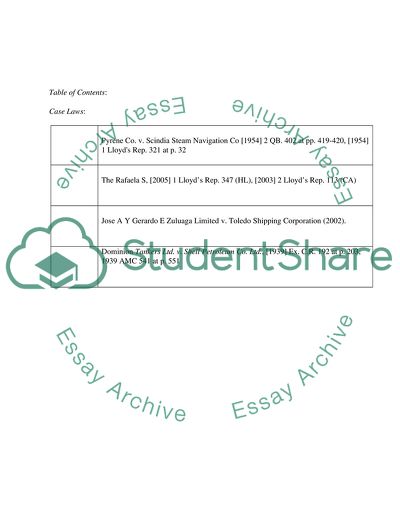Cite this document
(Application of the Hague Visby Rules Essay Example | Topics and Well Written Essays - 1500 words, n.d.)
Application of the Hague Visby Rules Essay Example | Topics and Well Written Essays - 1500 words. https://studentshare.org/law/1714871-when-do-the-hague-visby-rules-apply-state-the-obligation-of-a-sea-carrier-to-provide-a-seaworthy-ship-under-the-hague-visby-rules-give-examples-of-the-types-of-deficiency-that-will-result-in-a-vessel-being-unseaworthy
Application of the Hague Visby Rules Essay Example | Topics and Well Written Essays - 1500 words. https://studentshare.org/law/1714871-when-do-the-hague-visby-rules-apply-state-the-obligation-of-a-sea-carrier-to-provide-a-seaworthy-ship-under-the-hague-visby-rules-give-examples-of-the-types-of-deficiency-that-will-result-in-a-vessel-being-unseaworthy
(Application of the Hague Visby Rules Essay Example | Topics and Well Written Essays - 1500 Words)
Application of the Hague Visby Rules Essay Example | Topics and Well Written Essays - 1500 Words. https://studentshare.org/law/1714871-when-do-the-hague-visby-rules-apply-state-the-obligation-of-a-sea-carrier-to-provide-a-seaworthy-ship-under-the-hague-visby-rules-give-examples-of-the-types-of-deficiency-that-will-result-in-a-vessel-being-unseaworthy.
Application of the Hague Visby Rules Essay Example | Topics and Well Written Essays - 1500 Words. https://studentshare.org/law/1714871-when-do-the-hague-visby-rules-apply-state-the-obligation-of-a-sea-carrier-to-provide-a-seaworthy-ship-under-the-hague-visby-rules-give-examples-of-the-types-of-deficiency-that-will-result-in-a-vessel-being-unseaworthy.
“Application of the Hague Visby Rules Essay Example | Topics and Well Written Essays - 1500 Words”. https://studentshare.org/law/1714871-when-do-the-hague-visby-rules-apply-state-the-obligation-of-a-sea-carrier-to-provide-a-seaworthy-ship-under-the-hague-visby-rules-give-examples-of-the-types-of-deficiency-that-will-result-in-a-vessel-being-unseaworthy.


